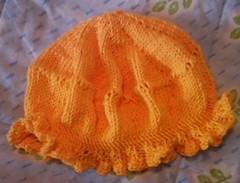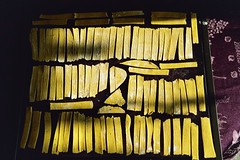It’s been awhile since I’ve been here, and I can’t honestly say it’s for any reason other than the fact that lately I have been having Huge Food Issues, and I got that post-holiday guilt-thing kicking in, which made me avoid mirrors, closets and scales for a bit. (What I should have been avoiding was the bloody TV. Could we STOP with the Slimfast ads, for just a week or two? Sheesh.) Now that my brain is safely back inside my body (or hovering nearby), we rejoin my daily obsession already in progress…
My buddy Jackie got the new Joy of Cooking, and man, am I jealous. (Yes, I am a cookbook whore.) She shifts the recipes just a titch to make them workable for a vegan-veggie type, and has reminded me of something I adore: roasted chickpeas. I first had them in a Peruvian  restaurant, mixed with roasted and salted hominy, and I’ve been striving to recapture that nutty, addictive tastiness ever since. The Peruvian folks probably fried their bar snacks instead of baking them, but I’m going to simply:
restaurant, mixed with roasted and salted hominy, and I’ve been striving to recapture that nutty, addictive tastiness ever since. The Peruvian folks probably fried their bar snacks instead of baking them, but I’m going to simply:
1.) Open and rinse a can of garbanzo beans,
2.) Turn them out onto a pan, and pat them a bit dry;
3.) Spritz them with a bit of olive oil, and sprinkle them with a tiny bit of salt, onion powder, curry powder, and turmeric,
4.) Oven roast them in a preheated, 400 degree oven for approximately (depending on your oven) thirty minutes, opening the oven to shake it about every ten minutes,
5.) Serve with chopped cilantro and lemon juice spritzed onto their crackly outsides, and inhale. Yum.
These chickpeas are tasty with the hominy (treated in the selfsame way) or mixed with raisins and dark chocolate chips as movie munchies. (Okay – if you like salt and sweet tastes together, this works. Otherwise, just ignore me.)
Been checking out some interesting blogs lately. Mac’s already remarked on the Post Punk People, and my find is Yeah, That Vegan Sh*t, a site about all things vegan, and Vegan Core, way fun because it has pretty pictures and plenty of recipes. I expect I’ll visit that one repeatedly; I’m always intrigued by people who test recipes and change them to suit. So much less work for me!
And speaking of less work – in my continuing quest to figure out what to do with that Vegemite, I’ve actually stuck my finger in it, and given it a taste. It’s really … not half bad. I’m still not up to it on toast (sorry, T&C), but it may have a future as more than just a soup base. My favorite use for it thus far? As a non powder form yeast in scrambled tofu. Here’s my updated take on it:
SCRAMBLED TOFU
1 lb. medium tofu (medium is better, for me – some prefer firm)
1 tbsp. oil, or use your sprayer as needed.
2 tbsp. snipped chives
1 tsp. onion powder, turmeric and curry powder
one crumbled sage leaf
1 tsp. Vegemite
After rinsing the tofu, I grab it in my fist and basically crumple it up. I toss the chunky bits into my lightly oiled pan and sprinkle heavily with onion powder and more lightly with turmeric and curry. The turmeric will give it a yellowy color that makes some people feel better about eating non-eggs. I then add the Vegemite, and let it soften in the heat before stirring it in. It adds both saltiness and a nice depth of flavor. Finish with the snipped chives and voilá!
Some people enjoy finely diced mushrooms in their scrambled tofu, grated carrots and other items. Imagine it as a chicken-egg omelet, and let your tastes be your guide. I prefer to keep it simple, unless I make this as a brunch item, then I really jazz it up, adding herbs and cheeses and Tofurky Italian sausages. I’ve heard chopped spinach and roasted sweet potato added to it is tasty… ah, to each their very own.
The remodel galumphs on… It’s definitely not galloping in any way, shape, or form. Still, it’s had its high points. We had a great little visit to KWW Kitchens & Baths in San Leandro, where we walked through Kitchen/Bath heaven, at least from the point of view of myriad cabinets, huge slabs of fabricated stone counter tops, slick modern fixtures, and more. It was well worth the trip down I-880, because it was really quite inexpensive. Most of the goods are likely from China, and we opted to go with real granite tiles on the counter instead of a fabricated slab, but it’s a definite check-it-out for Bay Area folks. (If you look at our remodel pics, you’ll see how it looks.) Of course, I feel quite scarred that we will not able to put an Aga range in our new kitchen, as Minty and Simon from Posh Nosh urged us to do. Alas, we ordinary mortals must make do without the hundred year old range that the fabulous Marchmont’s have at Crowe Hall, their house in Upper Berkshire which was built in 1685… sigh.
I think our builders over-estimated how easy this was going to be… now with tightly fitting cabinets (Mac is an EXACT mathematician; I think he has quite terrified the builders), ancient plumbing and cracked copper pipes, and the odd drooping ceiling, I believe they’re getting a little worried about the timetable. They thought they could fully gut and rebuild a tiny kitchen in just a week. Now we’re on to day five… two to go. They swear it’ll all be functioning on Monday. We’ll see. Meanwhile, the bamboo flooring is on order, and we expect it to be ready to go down on the floor by March. Hope springs eternal…




